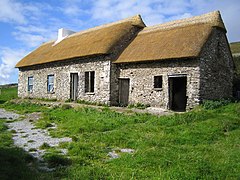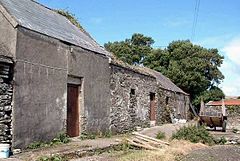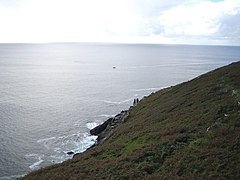Historic site in County Kerry, Ireland
| Fahan | |
|---|---|
 Fahan: The Dingle Peninsula coastline looking towards Slea Head and the Blasket Islands from the R559 road Fahan: The Dingle Peninsula coastline looking towards Slea Head and the Blasket Islands from the R559 road | |
| Location | County Kerry, Ireland |
| Coordinates | 52°06′06″N 10°25′17″W / 52.101615°N 10.421519°W / 52.101615; -10.421519 |
| Built | 13th century |
| Architectural style(s) | clochán |
 | |
Fahan is an area on the Dingle Peninsula in County Kerry, Ireland, noted for a collection of clochán, or drystone beehive huts. Fahan lies below Mount Eagle on the southern coast of the Dingle peninsula, to the west of the fishing village of Ventry and to the east of the steep cliffs of Slea Head. Fahan has many antiquities, including cave dwellings, stone beehive huts, stone monuments and forts.
Dunbeg Fort
Dunbeg Fort is located on a rocky promontory looking over Dingle Bay to the south. The cliffs have eroded since it was built, and much of the fort has been lost to the sea. The fort's wall cut off access to the triangular promontory, which was later occupied by a single large "beehive" hut. A visitor center at the site includes audiovisual displays, an information and craft room and a restaurant and café. The date at which the Dunbeg fort was built is very uncertain, although its structure resembles other Western Stone Forts. It may have been built around the same time as Iron Age blockhouse forts in Scotland such as the Crosskirk Fort in Caithness and the Clickimin Fort, Ness of Burgi Fort and Huxter Fort in Shetland.
Clochán
The collection of beehive houses at Fahan is said to be the most remarkable in Ireland. The date of the Fahan clochán is uncertain, since stone huts with this design have been built from Neolithic times to the twentieth century. Some of the earliest may have been built by hermit monks. However, it is thought that most of the clochán in this grouping dates to the twelfth century, when Norman invaders forced farmers from more prosperous areas to move to the marginal lands of the Dingle Peninsula. George Victor Du Noyer described the settlement when he visited in 1858. In his view the nearby Dunbeg Fort had been built to protect the community. However, the fort was built before 800 AD, and most likely during the Stone Age before the Christian Era.
Some of the stone huts in the Fahan group lay within stone ring forts. The cashels and clochán formed two clusters, or "cities", of the Fahan group. 460 have been counted, of which 414 are clochán. Most of them appear to be ancient, although some date to the middle of the nineteenth century. Their sizes range from 4 feet (1.2 m) to 22 feet (6.7 m) across, mostly round but sometime D-shaped or oval. They would have had corbelled stone roofs, giving them the shape of beehives.
Famine cottage
The Kavanaugh Famine Cottage is one of Fahan's tourist attractions. Once it had two rooms and a loft. The restored building has three rooms and two outhouses. It contains a selection of furniture and artifacts from the period of the Great Irish Famine. The cottage is on the north side of the R559 road, just west of the car park for Dunbeg Fort.
Gallery
-
Dunbeg promontory fort
-
 Famine Cottage - a museum of the Famine Years between 1845 and 1853
Famine Cottage - a museum of the Famine Years between 1845 and 1853
-
 Fahan Farm Buildings
Fahan Farm Buildings
-
 Steep pastures near Fahan
Steep pastures near Fahan
-
 View taken from the R559 road
View taken from the R559 road
-
Typical Clochán on the Dingle Peninsula
References
Citations
- Editors of Time Out 2011.
- Dillard & Causin 2008, p. 82.
- Kelleher 2006, p. 343.
- Promontory Forts, p. 286.
- Welcome to Dún Beag Fort.
- ^ Henderson 2007, p. 186.
- Murray 1866, p. 304.
- ^ Costa 2009, p. 212.
- Day 2006, p. 164.
- O'Curry 1873, p. 68.
- Kinahan 1884, p. 11.
- NormanSt Joseph 1969, p. 59.
- Valone 2009, p. 148.
Sources
- Costa, Kelli Ann (15 May 2009). COACH FELLAS: HERITAGE AND TOURISM IN IRELAND. Left Coast Press. ISBN 978-1-59874-407-1. Retrieved 7 February 2013.
- Day, Catharina (1 September 2006). Ireland. New Holland Publishers. ISBN 978-1-86011-327-7. Retrieved 7 February 2013.
- Dillard, Elsie; Causin, Susan (1 March 2008). The Irish Bed & Breakfast Book. Pelican Publishing. ISBN 978-1-58980-559-0. Retrieved 7 February 2013.
- Editors of Time Out (16 August 2011). Time Out Ireland: Perfect Places to Stay, Eat and Explore. Time Out Guides. p. 129. ISBN 978-1-84670-240-2. Retrieved 7 February 2013.
- Henderson, Jon C. (2007). The Atlantic Iron Age: Settlement and Identity in the First Millennium BC. Psychology Press. p. 186. ISBN 978-0-415-43642-7. Retrieved 7 February 2013.
- Kelleher, Suzanne Rowan (12 April 2006). Frommer's Ireland from $90 a Day. John Wiley & Sons. p. 343. ISBN 978-0-471-78941-3. Retrieved 7 February 2013.
- Kinahan, George H. (1884). "Proceedings". Journal of the Royal Society of Antiquaries of Ireland. The Society. Retrieved 7 February 2013.
- Murray, John (1866). Handbook for travellers in Ireland. J. Murray. p. 304. Retrieved 7 February 2013.
- Norman, E.R.; St Joseph, J.K.S. (1969). The Early Development Of Irish Society. CUP Archive. GGKEY:ZEYR2UEPWA4. Retrieved 7 February 2013.
- O'Curry, Eugene (1873). Lectures and appendix. Williams and Norgate. Retrieved 7 February 2013.
- "Promontory Forts". The Archaeology of Ireland. Taylor & Francis. 1998. p. 286. GGKEY:RPDUYE54HR0. Retrieved 7 February 2013.
- Valone, David A. (21 December 2009). Ireland's Great Hunger: Relief, Representation, and Remembrance. University Press of America. p. 148. ISBN 978-0-7618-4900-1. Retrieved 7 February 2013.
- "Welcome to Dún Beag Fort Visitor Centre". Dúnbeag Fort. Archived from the original on 28 September 2007. Retrieved 7 February 2013.